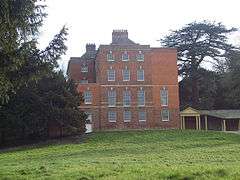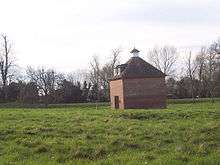Netheravon
Netheravon is a village and civil parish on the River Avon and A345 road, about 4 miles (6.4 km) north of the town of Amesbury in Wiltshire, South West England. It is within Salisbury Plain.
| Netheravon | |
|---|---|
 Netheravon House | |
 Netheravon Location within Wiltshire | |
| Population | 1,060 (in 2011)[1] |
| OS grid reference | SU148487 |
| Civil parish |
|
| Unitary authority | |
| Ceremonial county | |
| Region | |
| Country | England |
| Sovereign state | United Kingdom |
| Post town | Salisbury |
| Postcode district | SP4 |
| Dialling code | 01980 |
| Police | Wiltshire |
| Fire | Dorset and Wiltshire |
| Ambulance | South Western |
| UK Parliament | |
The village is on the right (west) bank of the Avon, opposite Fittleton. The parish extends west onto Netheravon Down.
History
A Roman villa stood near the Avon, on a site now south of Netheravon House.[2] Domesday Book recorded three landholdings with a total of 132 households.[3]
The Dukes of Beaufort had a large sporting estate at Netheravon in the early 18th century, which continued to be managed by their successors, the Hicks Beach family, until the end of the 19th century.[4]
The ancient parish included West Chisenbury, a detached tithing and hamlet to the north. This area was transferred to Enford parish in 1885.[4]
Much land in the area was bought by the War Department in 1898, including Netheravon House and almost the whole of Netheravon Parish, sold by Michael Hicks Beach. Gun ranges were established on the downs after the arrival of the army's machine gun school in 1922.[4]
A one-room school was built on the east side of the High Street c. 1846 and later became a National School. In 1871 49 pupils were recorded, rising to 90 in 1911 and 119 in 1926, in part due to the presence of the Flying Training School. In 1964 the school was amalgamated with that at Fittleton, with infants attending Netheravon and older children going to Fittleton. In the 1980s the school at Fittleton was closed and Netheravon became a primary school, on a new site towards the southern end of the High Street.[5]
Netheravon House

Netheravon house was built after 1734 as a hunting box for Henry Scudamore, Duke of Beaufort, possibly on the site of an earlier manor house.[4] The grounds were laid out before 1755 by Thomas Wright. In 1791 a block was added in the centre of the north front, for Michael Hicks Beach to designs of John Soane.[6] The three-storey house is built in brick and has five bays to its south entrance front, where there is a pedimented porch.[7]
An 18th-century dovecote stands in the grounds to the north of the house.[8] The large stable block of 1734–40 is also in brick, and surrounds four sides of a courtyard with a narrow opening to the north.[9] A colonnade links the house and stables.[7]
Following purchase by the War Department in 1898, the house and stables were the home of the Cavalry School from 1904. In 1975 the house served as the Officers' Mess for the Support Weapons Wing of the School of Infantry. In the 1990s the house, stables and grounds were sold by the Ministry of Defence.[10] In 2004 the house was converted into two homes and the stables into seven.[11][12] Avon Camp continues to occupy a site to the south.
In 1986 the house was recorded as Grade II* listed,[7] and the stables and dovecote Grade II.[9][8]
Parish church

A church was recorded in the Domesday survey of 1086.[3] The church of All Saints, built of rendered flint, has a tall west tower, its lower parts surviving from the 11th century.[13] The nave and chancel were built in the 13th century, and the aisles rebuilt in the 15th. Restoration in the 19th century, some by C.E. Ponting, included replacement of the roofs and chancel arch, and demolition of the north porch.[4][14]
The peal of bells in the tower was increased from five to six in 1911, and two were recast at the same time.[4] Of the others, one is dated 1585 and another 1695.[15] The church was recorded as Grade I listed in 1964.[14]
From the early 12th century until 1846, the church was a prebend of Salisbury Cathedral.[4] The benefice was united with Fittleton in 1953[16] and with Enford in 1973[17] but the parishes remained distinct. Today the church is part of the Avon River team ministry, which covers six parishes.[18]
Military camps
Cavalry School
Military activity was first established at Netheravon in 1904 with the creation of a cavalry school[19] under the sponsorship of Major General Robert Baden-Powell as the Inspector General of Cavalry. Baden-Powell envisioned developments in the use of Cavalry following his experiences in Southern Africa and India, and lessons from the Second Boer War. The school emphasised the use of cavalry for scouting and reconnaissance, recognising that the traditional effects of mass of cavalry had been diminished by the availability of modern weapons. The Officers' Mess was established at Netheravon House.
Aviation operations and training
Netheravon Airfield is outside the parish, on the other bank of the Avon in Fittleton and Figheldean parishes. A grass strip airfield was created for the Royal Flying Corps northeast of Coulston Camp (later called Airfield Camp) in 1913 and later became RAF Netheravon, an operational and training base. It was the home of No. 1 Flying Training School RAF from 1919 until 1931, and during the Second World War was used again for training and as a short-term base for operational squadrons, with glider and parachute activity from 1941. In 1963 the airfield and camp were transferred to the Army, and became AAC Netheravon (Army Air Corps) from 1966 until 2012.[20][21]
Avon Camp
With the establishment of the airfield in 1912, the Cavalry School continued to operate in the remaining training areas until the beginning of the war, re-opening briefly in 1919. In 1922 the school amalgamated with the Royal Artillery Riding Establishment in Northamptonshire and the site was taken over by the Machine Gun School, following a move from Grantham.
The Machine Gun School was absorbed as an element of the Small Arms School Corps in 1926. Over time the school expanded to encompass support weapons in general, becoming the Support Weapons Wing of SASC. Courses at Avon Camp included the use of:
- Mortar
- Heavy Machine Gun
- General Purpose Machine Gun – Sustained Fire
- Man Portable Anti-Tank
- Surveillance
Support Weapons Wing remained at Netheravon until 1995 when Avon Camp was closed and the Wing moved to the Land Warfare Centre, Warminster.
The part of the site known as Avon Camp West, on the A345 south of Netheravon, was proposed for the building of a new Royal Artillery Museum after the Firepower museum at Woolwich closed in 2016.[22] However, the offer of a lease of the site was withdrawn in 2020.[23]
Governance
The village is the most populous part of 'The Collingbournes and Netheravon' electoral ward. This ward starts in the west at Netheravon, stretches east to Collingbourne Ducis and ends in the east at Chute Forest. The population of this ward at the 2011 census was 4,186.[24]
In media
Channel 4 television programme Time Team briefly re-investigated the Roman villa site for a Series 4 episode, first broadcast in 1997.[25]
Notable people
Sydney Smith (1771–1845), later known as a humourist and writer, was a curate at Netheravon in the late 1790s and established a Sunday school. He left the parish after he was appointed travelling tutor to the son of Michael Hicks Beach.[4]
The writer Frank Sawyer (1906–1980), born nearby in Bulford, lived in Netheravon while employed as a river keeper on the Avon and died on the banks of the river near the parish church. He developed the Pheasant Tail Nymph for fly fishing and wrote the books Keeper of the Stream and Nymphs and the Trout.[26]
Oliver Kite (1920–1968) was an equally well known fly fisherman who, from 1958 until his death on the River Test from a heart attack, lived on the High Street as a near neighbour of Sawyer. He presented a Southern television series, Kite's Country, and wrote Nymph Fishing in Practice. He is buried in the Churchyard of the adjoining parish of Fittleton
References
- "Wiltshire Community History – Census". Wiltshire Council. Retrieved 13 March 2015.
- Historic England. "Roman Bath House (218930)". PastScape. Retrieved 20 June 2019.
- Netheravon in the Domesday Book
- Baggs, A.P.; Crittall, Elizabeth; Freeman, Jane; Stevenson, Janet H (1980). Crowley, D.A. (ed.). "Victoria County History: Wiltshire: Vol 11 pp165-181". British History Online. University of London. Retrieved 1 October 2016.
- "All Saints Church of England VA Primary School, Netheravon". Wiltshire Community History. Wiltshire Council. Retrieved 23 June 2019.
- "Netheravon House, Wiltshire: alterations and additions and designs for lodges for Michael Hicks Beach, 1791". Sir John Soane's Museum. Retrieved 23 June 2019.
- Historic England. "Netheravon House (1299956)". National Heritage List for England. Retrieved 23 June 2019.
- Historic England. "Dovecote at Netheravon House (1033902)". National Heritage List for England. Retrieved 23 June 2019.
- Historic England. "Stables to Netheravon House (1033957)". National Heritage List for England. Retrieved 23 June 2019.
- "Land at Netheravon House: Archaeological Watching Brief" (PDF). Cotswold Archaeology. October 2006. Retrieved 23 June 2019.
- "Mansions attract the cut-price country set". This is Money. 2 July 2004. Retrieved 26 June 2019.
- "THE STABLES, NETHERAVON, WILTSHIRE". OnTheMarket. Retrieved 23 June 2019.
- "All Saints, Netheravon, Wiltshire". Corpus of Romanesque Sculpture. King's College London. Retrieved 15 June 2019.
- Historic England. "Church of All Saints (1033956)". National Heritage List for England. Retrieved 15 June 2019.
- "Netheravon, All Saints". Dove's Guide for Church Bell Ringers. Retrieved 15 June 2019.
- "No. 40001". The London Gazette. 30 October 1953. pp. 5776–5777.
- "No. 46042". The London Gazette. 31 July 1973. p. 9036.
- "Avon River Team". Retrieved 15 June 2019.
- "Netheravon". Wiltshire Community History. Wiltshire Council. Retrieved 13 March 2015.
- Cocroft, Wayne; Holborow, Will; Lake, Jeremy; Thomas, Roger (2011). "Ministry of Defence disposals: Wiltshire (115-2011)" (PDF). English Heritage. pp. 91–99. Archived from the original (PDF) on 20 September 2016. Retrieved 19 September 2016.
- "Airfield Camp, Netheravon 1912-2012" (PDF). Army Air Corps Journal (52): 40–42. 2012. Retrieved 19 September 2016.
- Griffin, Katy (13 March 2020). "Plans for new museum to preserve regiment's history". Salisbury Journal. Retrieved 25 July 2020.
- "Army Headquarters removes support for lease of land at Avon Camp West for the development of the Royal Artillery Museum". Figheldean Parish Council. 30 May 2020.
- "The Collingbournes and Netheravon ward 2011. Retrieved 15 March 2015".
- "Time Team – Episode Guide". Channel 4. Retrieved 20 June 2019.
- Vines, Sidney (1984). Frank Sawyer – Man of the Riverside. London: George Allen & Unwin. ISBN 0-04-799023-6.
Further reading
- Netheravon Conservation Area Statement, Kennet District Council, 2002
External links
![]()